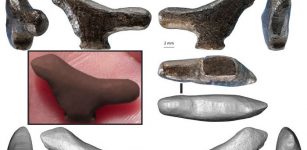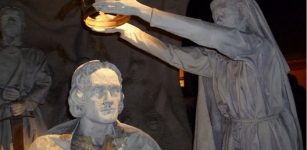Unraveling The Mystery Behind The Perplexing Story Of Pied Piper Of Hamelin
Ellen Lloyd - AncientPages.com - There was something magical about the sound of his pipe. It had a strange effect on the 130 children who followed him into the woods. They entered the cave and were never seen again.
Hundreds of years ago, something strange and unexplained happened in the small village of medieval Hameago. How could a man lure all those children into a trap, and how could they vanish without a trace?
The Pied Piper of Hamelin by James Elder Christie (1847–1914). Credit: Public Domain
Did you ever hear the story of Pied Piper of Hamelin when you were a child? The story is still often told to children worldwide, and it is a disturbing tale. As it so often is with folktales, there is, in fact, some truth in the Pied Piper story. What transpired on that crucial day if the story is based on reality?
The Pied Piper of Hamelin, also known as Pan Piper, the Rat-Catcher of Hamelin, is based on a legend from the town of Hamelin, Lower Saxony, Germany.
The mayor, in turn, promised to pay him to remove the rats. The Piper accepted and played his magical pipe to lure the rats into the Weser River, where all but one drowned.
However, he sought revenge when the villagers refused to pay for the services. He played on his pipe that had magical powers affecting the children and led them away in the same way as he got rid of the rats. He lured 130 children into the woods, where they entered a cave and were never to be seen again. One version of this disturbing story tells that three children remained behind.
One of them was lame and could not follow quickly enough, the second was deaf and followed the other children out of curiosity, and the last was blind and unable to see where he was going. These three informed the villagers of what had happened when they came out of the church. This version of the story spread as folklore and appeared in Johann Wolfgang von Goethe, the Brothers Grimm, and Robert Browning, among others. The Pied Piper is sometimes thought to have been associated with the Norse God Odin or the Anglo-Saxon counterpart Woden.
Interestingly, long before the Brothers Grimm chronicled the fairy tale in their anthology of stories, curious writings regarding the Piper story appeared.
For example, a document from 1384 about HamelinHamelin'sy states that an unrelated event took place "…100 y" ars since our children left." Dated" to about 1440 C.E., another manuscript states: "In the "year of 1284, on June 26…a piper, clothed in many kinds of colors, (there were) 130 children born in Hamelin were seduced, and lost at the place of execution near the hill." It is "also puzzling that none of the manuscripts mention of rats. Even today, the historical background of Pied Piper'sPiper's can not be proved.
Among the various interpretations, reference to the colonization of East Europe starting from Low Germany is the most plausible one: The "Children of Hameln" would have been in those days citizens willing to emigrate being recruited by landowners to settle in Moravia, East Prussia, Pomerania or in the Teutonic Land. It is assumed that in past times all people of a town were referred to as "children of the town" or "town children" as is frequently done today.
Historian Ursula Sautter, citing the work of linguist Jurgen Udolph, offers this hypothesis in support of the emigration theory: "After the defeat of the Danes at the Battle of Bornhöved in 1227," explains Udolph, "the region south of the Baltic Sea, which was then inhabited by Slavs, became available for colonization by the Germans." The bishops and dukes of Pomerania, Brandenburg, Uckermark, and Prignitz sent out glib "locators," medieval recruitment officers, offering rich rewards to those who were willing to move to the new lands.
1909 Maxfield Parrish mural of the Pied Piper of Hamlin at the Palace Hotel, San Francisco. Credit: Public Domain
Several researchers have studied the Pied Piper story to unravel the mystery, but without any success. Thousands of young adults from Lower Saxony and Westphalia headed east. And as evidence, about a dozen Westphalian place names show up in this area. Indeed there are five villages called Hindenburg running in a straight line from Westphalia to Pomerania, as well as three eastern Spiegelbergs and a trail of etymology from Beverungen south of Hamelin to Beveringen northwest of Berlin to Beweringen in modern Poland.
Many theories have been put forward. Some suggest that children died of natural causes such as disease or accident and that the Piper was a symbolic figure of Death.

Modern concepts of Death Today people tend not to believe that a grim reaper will appear at their door when it is time to depart from this life.
Analogous themes associated with this theory include the Dance of Death, Totentanz, or Danse Macabre, a common medieval trope. Some of the scenarios suggested as fitting this theory include that the children drowned in the river Weser were killed in a landslide, or contracted some disease during an epidemic. Another modern interpretation reads the story as alluding to an event where Hamelin children were lured away by a pagan or heretic sect to forests near Coppenbrügge (the mysterious Koppen "hills" of the" poem) for ritual dancing where they all perished during a sudden landslide or collapsing sinkhole.
Others have suggested that the children left Hamelin to be part of a pilgrimage, a military campaign, or even a new Children's crusade (which is said to have occurred in 1212) but never returned to their parents. These theories see the unnamed Piper as their leader or a recruiting agent. The townspeople made up this story (instead of recording the facts) to avoid the church's wrath or the king.
The identity of Pied Piper remains a mystery. We also do not know what happened to all those children who vanished and were never seen again. Ask yourself why 130 children would willingly follow a stranger into the woods. Perhaps we will never find out what happened, but think twice before telling your child this story next time.
Updated on December 12, 2023
Written by – Ellen Lloyd - AncientPages.com
Copyright © AncientPages.com All rights reserved. This material may not be published, broadcast, rewritten or redistributed in whole or part without the express written permission of AncientPages.com
More From Ancient Pages
-
 Crimean Atlantis: Remarkable Ancient Underwater City Of Akra
Featured Stories | Mar 6, 2017
Crimean Atlantis: Remarkable Ancient Underwater City Of Akra
Featured Stories | Mar 6, 2017 -
 Young Boy Finds A Huge Tooth From A Prehistoric Shark In South Carolina
Archaeology | Sep 3, 2022
Young Boy Finds A Huge Tooth From A Prehistoric Shark In South Carolina
Archaeology | Sep 3, 2022 -
 Paleolithic Standing Bird Figurine – East Asian 3-D Art – Recovered From Refuse Heap
Archaeology | Jun 23, 2020
Paleolithic Standing Bird Figurine – East Asian 3-D Art – Recovered From Refuse Heap
Archaeology | Jun 23, 2020 -
 Mysterious Figurine Of Mythical Individual Dates Back To Egypt’s Naqada Culture 4400–3000 BC
Featured Stories | Sep 25, 2016
Mysterious Figurine Of Mythical Individual Dates Back To Egypt’s Naqada Culture 4400–3000 BC
Featured Stories | Sep 25, 2016 -
 India: Plastic Surgery And Genetic Science – Found In Ancient Vedas – Were Practiced Thousands Of Years Ago
Ancient Technology | Oct 29, 2014
India: Plastic Surgery And Genetic Science – Found In Ancient Vedas – Were Practiced Thousands Of Years Ago
Ancient Technology | Oct 29, 2014 -
 Mystery Of The Giant Hand At The Temple Of Hercules
Featured Stories | Jul 17, 2019
Mystery Of The Giant Hand At The Temple Of Hercules
Featured Stories | Jul 17, 2019 -
 On This Day In History: Robert I, King Of Scots Known As ‘Robert The Bruce’ Was Born – On July 11, 1274
News | Jul 11, 2016
On This Day In History: Robert I, King Of Scots Known As ‘Robert The Bruce’ Was Born – On July 11, 1274
News | Jul 11, 2016 -
 What Was Legio Martia And Why Were The Roman Soldiers Called The Martians?
Ancient History Facts | Jan 5, 2018
What Was Legio Martia And Why Were The Roman Soldiers Called The Martians?
Ancient History Facts | Jan 5, 2018 -
 Alexander The Great’s Mysterious And Unexplained Encounter In Babylon
Ancient Mysteries | Jul 15, 2021
Alexander The Great’s Mysterious And Unexplained Encounter In Babylon
Ancient Mysteries | Jul 15, 2021 -
 Satellite Images Reveal A Mysterious Ancient Site On A Remote Island Is Much Larger Than Previously Thought, Prompting New Questions
Archaeology | Nov 28, 2024
Satellite Images Reveal A Mysterious Ancient Site On A Remote Island Is Much Larger Than Previously Thought, Prompting New Questions
Archaeology | Nov 28, 2024 -
 Florida’s Ancient Calusa Kingdom Developed Sophisticatedly Engineered ‘Watercourts’
Archaeology | Apr 1, 2020
Florida’s Ancient Calusa Kingdom Developed Sophisticatedly Engineered ‘Watercourts’
Archaeology | Apr 1, 2020 -
 Pyramid Of Unknown Ancient Egyptian Queen And Hundreds Of Mummies Discovered In Saqqara
Archaeology | Nov 17, 2022
Pyramid Of Unknown Ancient Egyptian Queen And Hundreds Of Mummies Discovered In Saqqara
Archaeology | Nov 17, 2022 -
 Unique Statue Of Warrior Wearing A Phrygian Cap Accidently Discovered By Dutch Fishermen
Archaeology | Aug 2, 2022
Unique Statue Of Warrior Wearing A Phrygian Cap Accidently Discovered By Dutch Fishermen
Archaeology | Aug 2, 2022 -
 Evidence Of An Advanced Ancient Civilization In Texas That Mysteriously Disappeared
Ancient Mysteries | Jul 18, 2024
Evidence Of An Advanced Ancient Civilization In Texas That Mysteriously Disappeared
Ancient Mysteries | Jul 18, 2024 -
 How Ramesses II Became The Greatest Pharaoh In Egypt
Featured Stories | Jun 6, 2021
How Ramesses II Became The Greatest Pharaoh In Egypt
Featured Stories | Jun 6, 2021 -
 Linked Human Skeletons Lying In Spiral Circle Unearthed In Pre-Aztec Burial Pit Near Mexico City
Archaeology | Feb 7, 2018
Linked Human Skeletons Lying In Spiral Circle Unearthed In Pre-Aztec Burial Pit Near Mexico City
Archaeology | Feb 7, 2018 -
 Deciphered Ancient Stone Tablets Contain Sacred Knowledge That Could Re-Write History
Civilizations | Aug 28, 2018
Deciphered Ancient Stone Tablets Contain Sacred Knowledge That Could Re-Write History
Civilizations | Aug 28, 2018 -
 Runic Inscription On The Viking-Age Galloway Hoard Deciphered
Archaeology | Feb 13, 2025
Runic Inscription On The Viking-Age Galloway Hoard Deciphered
Archaeology | Feb 13, 2025 -
 Creator God Kururumany Who Introduced Death Into The World And Deprived Humans Of Immortality
Featured Stories | Dec 19, 2016
Creator God Kururumany Who Introduced Death Into The World And Deprived Humans Of Immortality
Featured Stories | Dec 19, 2016 -
 Underground Ancient City Of Kish And Its Advanced Hydraulics System
Ancient Technology | Aug 28, 2015
Underground Ancient City Of Kish And Its Advanced Hydraulics System
Ancient Technology | Aug 28, 2015



